An Endangered Species dark chocolate bar goes to the first person who emails me with the correct count of bison calves in this photo!

Other photos from today:



An Endangered Species dark chocolate bar goes to the first person who emails me with the correct count of bison calves in this photo!

Other photos from today:



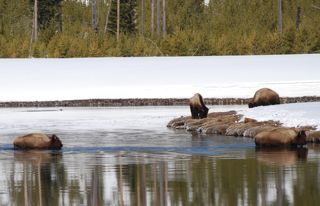 On my drive back from West Yellowstone this morning, I stopped frequently and explored the Madison River area in the western portion of the park. Although the sun was bright, snow had fallen in abundance over the past two days, and the park had closed the road to the public twice from Mammoth Hot Springs to Norris, only allowing administrative traffic with 4WD because of blizzard conditions.
On my drive back from West Yellowstone this morning, I stopped frequently and explored the Madison River area in the western portion of the park. Although the sun was bright, snow had fallen in abundance over the past two days, and the park had closed the road to the public twice from Mammoth Hot Springs to Norris, only allowing administrative traffic with 4WD because of blizzard conditions.
My declarations of spring have definitely been premature--most of the park remains entrenched in winter. Some portions of the river remained under ice and snow, and elk and bison grazed in the small patches of uncovered ground.
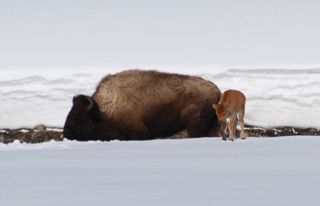 The Madison River runs 183 miles through Montana and Wyoming and is a headwater tributary of the Missouri River. Lewis and Clark named the river in 1805 for then US Secretary of State James Madison. I'm also told the river is paradise for fly-fisherman, especially in fall for rainbow and brown trout.
The Madison River runs 183 miles through Montana and Wyoming and is a headwater tributary of the Missouri River. Lewis and Clark named the river in 1805 for then US Secretary of State James Madison. I'm also told the river is paradise for fly-fisherman, especially in fall for rainbow and brown trout.
A small herd of bison crossed the river while I watched, and a small calf walked tiredly through the snow. A dozen elk also lingered in one of the areas left bare by snowmelt, and Canadian geese strolled along the banks of the river.
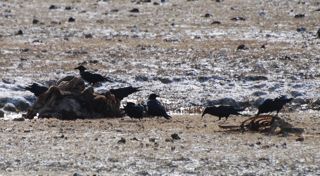 Further up the river, I discovered a less idyllic scene: ravens perched on the carcass of a bison. The long winter has taken its toll on the Yellowstone ungulate population, and winter kill has been high this year. I waited an hour to see if a wandering grizzly or a pack of wolves would come claim the kill, but the ravens had the feast to themselves.
Further up the river, I discovered a less idyllic scene: ravens perched on the carcass of a bison. The long winter has taken its toll on the Yellowstone ungulate population, and winter kill has been high this year. I waited an hour to see if a wandering grizzly or a pack of wolves would come claim the kill, but the ravens had the feast to themselves.
 On the way home from our conference, we stopped near the Madison River to watch newborn bison calves romp around. One calf even still had its umbilical cord. Although I love bison and think them beautiful animals, the word "cute" never came to mind in their presence--until now. Bison calves are pretty darn cute. A flock of Canadian geese lingered nearby and we also observed a bald eagle perched on a lodgepole pine near the river. For the next month or so, Yellowstone will be cuteness central as the resident animals give birth in spring. I am looking forward to seeing my first wolf pups soon!
On the way home from our conference, we stopped near the Madison River to watch newborn bison calves romp around. One calf even still had its umbilical cord. Although I love bison and think them beautiful animals, the word "cute" never came to mind in their presence--until now. Bison calves are pretty darn cute. A flock of Canadian geese lingered nearby and we also observed a bald eagle perched on a lodgepole pine near the river. For the next month or so, Yellowstone will be cuteness central as the resident animals give birth in spring. I am looking forward to seeing my first wolf pups soon!



 The Mammoth Visitor Center shut down temporarily today when two women locked themselves to a post to protest the National Park Service's killing of over 1,000 Yellowstone bison since February. CNN and CBS were among the media onsite.
The Mammoth Visitor Center shut down temporarily today when two women locked themselves to a post to protest the National Park Service's killing of over 1,000 Yellowstone bison since February. CNN and CBS were among the media onsite.
As you can imagine this is quite a heated issue in this area. Once the bison wander outside the park borders, which they do often in the winter in search of food, they are essentially unprotected.
The New York Times ran a good article on the issue this past Sunday http://www.nytimes.com/2008/03/23/us/23bison.html?_r=1&scp=1&sq=yellowstone+bison&st=nyt&oref=slogin



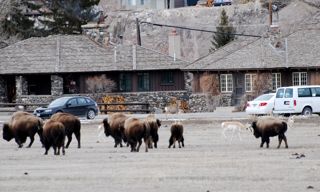 The northern range of Yellowstone has been dubbed by many the "American Serengeti" due to both the quantity and diversity of the wildlife. And I live right in the prime winter range of this area--creatures venture in my frontyard searching for forage at the lower elevations. I will miss my neighbors in the summer when they head for higher ground as I am now used to an assortment of animals greeting me when I open my door. See photo at right--that's my house and black Subaru amidst the bison, pronghorn and mule deer traffic!
The northern range of Yellowstone has been dubbed by many the "American Serengeti" due to both the quantity and diversity of the wildlife. And I live right in the prime winter range of this area--creatures venture in my frontyard searching for forage at the lower elevations. I will miss my neighbors in the summer when they head for higher ground as I am now used to an assortment of animals greeting me when I open my door. See photo at right--that's my house and black Subaru amidst the bison, pronghorn and mule deer traffic!
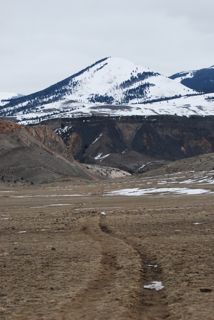 Today I hiked up the Rescue Creek Trail in search of bighorn sheep. I always hoped to see these delightful creatures in my wanderings in the Sierra high country, but the nearest I came was finding their scat on a hike up the Granite Divide. I've been lucky enough to see the bighorn twice since I've been in the park, but they're the one ungulate that doesn't frequent my front yard.
Today I hiked up the Rescue Creek Trail in search of bighorn sheep. I always hoped to see these delightful creatures in my wanderings in the Sierra high country, but the nearest I came was finding their scat on a hike up the Granite Divide. I've been lucky enough to see the bighorn twice since I've been in the park, but they're the one ungulate that doesn't frequent my front yard.
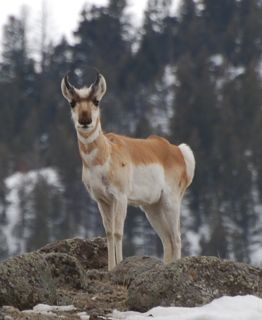 In just a five minute walk from my house, I arrived in a beautiful basin over 6,000 feet. I stopped frequently to scope out the ridge with my binoculars, and to watch the elk and pronghorn I encountered. I climbed up Rattlesnake Butte for a view of the Yellowstone River canyon, and tried to create an interesting backstory for the adjacent Turkey Pen Peak. For fifteen minutes I stood and observed two resting pronghorn antelope, but the bighorn sheep remained elusive.
In just a five minute walk from my house, I arrived in a beautiful basin over 6,000 feet. I stopped frequently to scope out the ridge with my binoculars, and to watch the elk and pronghorn I encountered. I climbed up Rattlesnake Butte for a view of the Yellowstone River canyon, and tried to create an interesting backstory for the adjacent Turkey Pen Peak. For fifteen minutes I stood and observed two resting pronghorn antelope, but the bighorn sheep remained elusive.
Day two of wandering through the peaceable kingdom. My front yard seems to be the new cool hangout for ungulates. Perhaps they heard about all those donations I made to animal rights groups?
Resting elk near the Yellowstone river
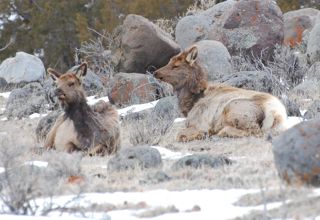
One looks at me curiously
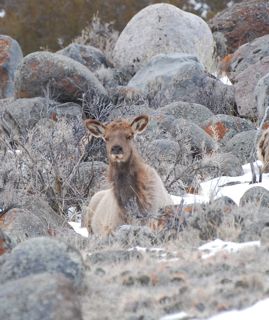
Nearby a herd of mule deer nap in the sun
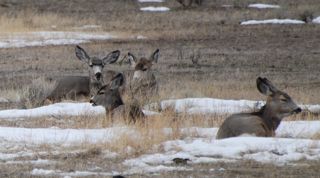
Itchy!
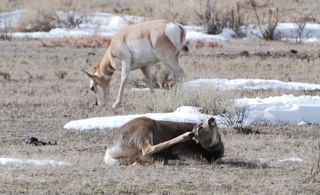
The dainty pronghorn also showed up for the ungulate gathering
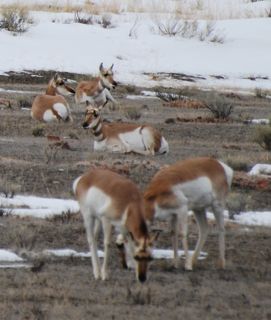
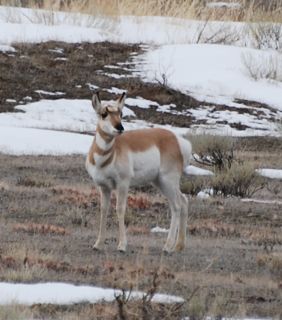
And an ungulate trifecta: elk, bison, and pronghorn all in one photo!
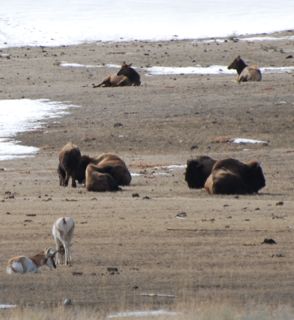
Imagine opening your front door to a herd of bison or walking to the post office being followed by a few young elk. I keep marveling over the assortment of creatures wandering around Yellowstone. Below is a photo diary of my animal encounters just today.
I open my front door and I see........
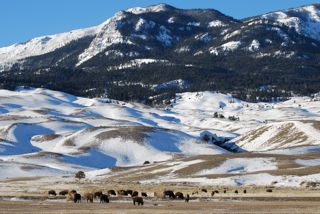
...elk and bison grazing on the grass newly revealed by the melting snow.
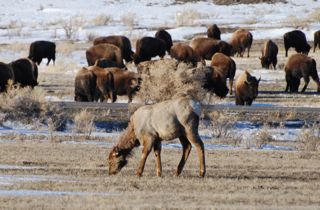
A bison strolls to my house, probably looking for my chocolate stash.
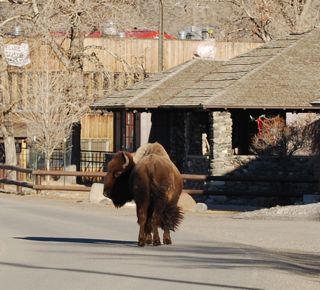
On my way to the Mammoth Hot Springs Post office, I pass an elk inspecting the cars,
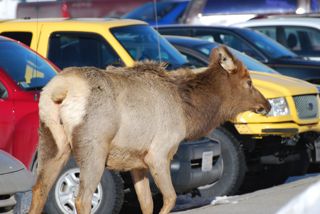
while his buddy maneuvers through the snow,
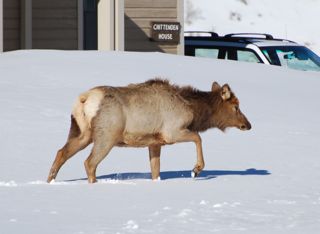
and others graze nearby,
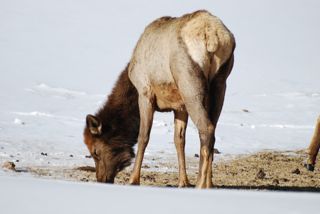
some with a cottontail companion!
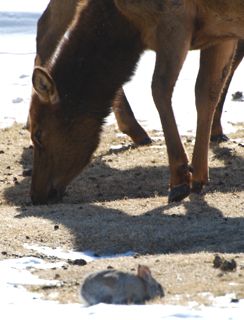
Recently, a herd of bison have been walking--single file--down from the hills in the morning to forage in my neighborhood. I don't think I'll ever tire of watching these magnificent animals. I took the photograph at right this afternoon from my front yard, ready to dash back inside if they got frisky.
I bought a delightful book today from the Yellowstone Association store: The Buffalo Story-The Full Saga of the American Animal by David Dary. It's 400 pages of everything you ever wanted to know about the buffalo--from prehistoric origins to modern day buffalo ranching. And before you cry, it's called bison, not buffalo, read what the author of the book has to say on the nomenclature issue:
"What we call the American buffalo is, of course, not a buffalo at all. It is a Bison, which is related to the European Wisent. The scientific world insists that the word "buffalo" should be used only to describe the African buffalo or the water buffalo of Asia. But for more than 150 years this animal, the bison, has been called a "buffalo." To millions of people he is a buffalo, and on these pages this is what I call him."
As for the origin of the word buffalo, the author provides a few clues. It appears that the early French and Spanish explorers knew their species, since they referred to the animal as Bison d'Amerique and bisonte respectively. Boeuf, the Canadian term, along with buffelo, a word used by later French explorers, gets phoenitically closer to the modern term of buffalo.
 A typical day cross country skiing in Yellowstone: bull elk resting in the snow, bison wandering down the ski trail, wolf tracks and scat scattered on the terrain, and water running under the translucent blue ice of a frozen waterfall.
A typical day cross country skiing in Yellowstone: bull elk resting in the snow, bison wandering down the ski trail, wolf tracks and scat scattered on the terrain, and water running under the translucent blue ice of a frozen waterfall.
My co-worker, Marti, and I took an afternoon ski to Tower Falls—a rather small fall by Yosemite standards at 132 feet, but beautiful nonetheless. Watching the water flow beneath the waterfall’s frozen coating was mesmerizing. I also learned the best strategy for dealing with the appearance of a bison herd in your ski path—make a wide berth around! Of course as soon as we had broke trail through the powder and arrived at the other side, the bison had removed themselves. I think they just like watching skiers do extra work.
 After the ski, my neighbors of about 20 feet away invited me to a superbowl party. I dined on elk, moose, and mule deer, along with homemade enchiladas and sushi—all well earned after my ski excursion. I’m glad I went as most attendees were Giants fans, and New England needed a representative. I didn’t have any Patriots gear, so I wore my Red Sox hat.
After the ski, my neighbors of about 20 feet away invited me to a superbowl party. I dined on elk, moose, and mule deer, along with homemade enchiladas and sushi—all well earned after my ski excursion. I’m glad I went as most attendees were Giants fans, and New England needed a representative. I didn’t have any Patriots gear, so I wore my Red Sox hat.
 I realized how old I am when one of the teenagers at the party asked me who the creepy old guy was singing at half time. My friend Michelle and I have a strong opinion that rock stars should not be allowed to play after 50, which this teenager further vindicated. I'm not a football fan, but how can the Pats lose after a perfect season? Actually, I am glad. Us New Englanders like being the losers and underdogs; our teams have been winning too frequently of late. Let's give it another 80 years before the next national victory-it builds character.
I realized how old I am when one of the teenagers at the party asked me who the creepy old guy was singing at half time. My friend Michelle and I have a strong opinion that rock stars should not be allowed to play after 50, which this teenager further vindicated. I'm not a football fan, but how can the Pats lose after a perfect season? Actually, I am glad. Us New Englanders like being the losers and underdogs; our teams have been winning too frequently of late. Let's give it another 80 years before the next national victory-it builds character.
 Nicole, the wonderful coordinator of the Yosemite Association Museum Store in Yosemite Valley, requested an update about bison and I'm happy to oblige. First, never call them buffalo in Yellowstone as you'll immediately be corrected by anybody in your vicinity. Bison and buffalo belong to the same family (Bovidae), but only the Asian Water Buffalo and African Buffalo can accurately claim the buffalo title.
Nicole, the wonderful coordinator of the Yosemite Association Museum Store in Yosemite Valley, requested an update about bison and I'm happy to oblige. First, never call them buffalo in Yellowstone as you'll immediately be corrected by anybody in your vicinity. Bison and buffalo belong to the same family (Bovidae), but only the Asian Water Buffalo and African Buffalo can accurately claim the buffalo title.
Yellowstone has a healthy population today of about 4,700, yet in 1886 the herd had dwindled to roughly 50 animals before the U.S. Army saved the day. The park is the only place in the lower 48 states where a continous population of bison has persisted since prehistoric times.
Bison are big animals and can weigh up to 2,000 lbs and stand 6 feet tall. One of my favorite moments on the wolf course was watching a wolf run through a bison herd and playfully banter with a large bison--but keeping his distance. Bison are not to be messed with.
 Last week I watched several herds in the snow-covered whiteness of Lamar Valley search for food. The big animal first shakes his big head in the snow, making a sort of bison snow angel. When his head emerges, he has a white beard. Next, he paws through the bottom layer trying to uncover vegetation. Not an easy winter existence.
Last week I watched several herds in the snow-covered whiteness of Lamar Valley search for food. The big animal first shakes his big head in the snow, making a sort of bison snow angel. When his head emerges, he has a white beard. Next, he paws through the bottom layer trying to uncover vegetation. Not an easy winter existence.
On my morning drive to work, I usually see a herd foraging near the Gardiner River, or huddling near the thermals in Mammoth. Last week a small group gathered in the football field at the school in Gardiner.
PS: Say hi to Nicole next time you're in Yosemite and check out the wonderful Native American handcrafts at her store. Beware--she's good at selling stuff!